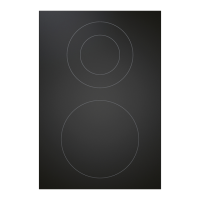Functions and operation
EN
28 www.bora.com
Operating instructions:
The use of a gas cooktop results in the formation of heat and
moisture in the area where it is installed. Intensive use of the
appliance for a long time may require additional ventilation, e.g.
opening a window or more effective ventilation, e.g. operation of the
mechanical ventilation device at a higher power level.
u
Ensure sufficient ventilation.
u
Keep natural ventilation openings open.
u
Use a mechanical ventilation device if possible.
u
Do not put cookware with an uneven base on the pan support.
u
Never heat empty cookware.
u
Always place the cookware on the pan support provided. Cookware
must not be placed directly on the burner.
u
Do not use roasters, pans or stone grills that are so large that they
cover several burners. The resulting heat accumulation can
damage the cooktop.
u
Ensure that the burner parts and pan supports are positioned
correctly.
u
Do not switch the gas cooktop on until all burner parts are
correctly assembled.
u
Ensure that the burner flame does not protrude from under the
base of the cookware and rise up the outside of the pot.
u
Do not keep any highly flammable objects near the cooktop.
Only use cookware with a diameter that is within the given
dimensions. If the diameter is too large, the hot gases and
flames flowing outwards from under the base may damage
the worktop or any non-heat-resistant surfaces, e.g. walls
with panelling, as well as parts of the cooktop and the
cooktop extractor. Bora shall not be held liable for any such
damage.
Do not use the gas cooktop without cookware for extended
periods of time (>5 min) with the cooktop extractor switched
on. This results in very high temperatures and may damage
the gas cooktop and air-channelling components of the
cooktop extractor.
The tips of the flames should remain under the base of the
pot. Protruding flame tips emit heat into the air unnecessarily
and can damage pan handles and air-channelling components
(cooktop extractor) and increase the risk of burns.
Furthermore, the outer part of the gas flame is much hotter
than the core.
Protect your hands when the appliance is hot by using oven
gloves or pot holders. Only use dry gloves or pot holders. Wet
or damp fabrics conduct heat more easily and can cause
steam burns. Ensure that these fabrics do not get too close to
the flames. Do not use oversized pot holders, tea towels or
similar.
Grease splashes and other flammable (food) residues on the
cooktop can catch fire. Remove them as soon as possible.
For maximum performance with minimum gas
consumption, we recommend that you:
u
use cookware with a base that covers the flame entirely so that
this does not burn beyond the base;
u
use suitable pans on each gas burner;
u
position the cookware centrally on the gas hob;
u
set the gas burner to the lowest power level (small flame) once the
pan contents are simmering;
u
adjust the power level of the cooktop extractor to the power level
of the gas cooktop.
Using the gas cooktop with a cooktop extractor:
If the gas cooktop is used together with a cooktop extractor, the
airflow of the extractor can affect the gas flame.
u
Avoid using a high power level on the cooktop extractor when the
gas cooktop is set to a low power level.
u
If necessary, reduce the power level on the cooktop extractor
when you turn on the gas cooktop.
u
Do not use the gas cooktop without cookware. The gas flame is
protected from the airflow of the cooktop extractor by the
geometry of the pan supports and the cookware.
u
If necessary, reduce the power level on the cooktop extractor to
improve heat input or distribution.
Flames can set fire to or damage the grease filter in the
cooktop extractor and the air-channelling components. Never
flambé food when using a cooktop extractor.
The performance characteristics of the gas cooktop (e.g.
heating times, efficiency, etc.) are affected by the cooktop
extractor. The cooktop extractor also affects the heat input
and distribution.
In recirculation mode the recirculated air affects the gas
cooktop. If the gas flame goes out, is excessively affected by
the extractor and/or the flame is not as it should be (e.g. soot
production, flame blowback, etc.), the return flow aperture
must be enlarged.
5.5.4
Setting cooking zone power levels
The power levels are controlled by turning the knob ring to the
desired power level (electronic power adjustment).
Increasing the power level
u
Turning the knob ring clockwise
Reducing the power level
u
Turning the knob ring anticlockwise
T
The selected power level is shown in the display on the extractor
control knob.
Fig.5.25
Setting cooking zone power levels
Setting the temperature on the Tepan stainless steel grill
u
Turn the knob ring to the desired temperature.
T
The control knob display shows the target temperature for 3
seconds. Then the warm-up phase begins.
T
During the warm-up phase, the corresponding cooking zone display
flashes and the current temperature is shown.

